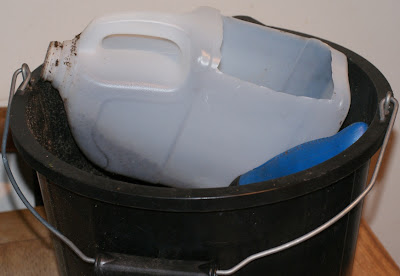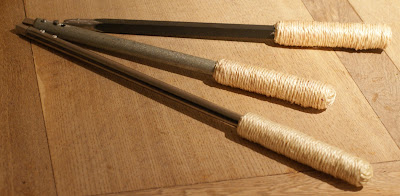I've been messing around with bits of wood again :-)
This time I've been making pencil or in my case pen grips, you know the type of things that you put onto a pen or pencil to help you ... well grip it better.
I used to draw (or doodle if you prefer) when I was younger and I've recently taken it up again, basically I spend time drawing abstract pieces of artwork with fine line pens.
Stuff like this -
Now as is the case with most things it seems that pens have changed over the years (why wouldn't they ?) and they are thinner than I remember, at least the ones I have chosen to use, or maybe it's my fingers that have got bigger ? either way gripping the pens is problematic at times, I have had operations on my hands which has dulled the senses in my finger tips some what, this doesn't help.
So a quick and simple solution was a grip, yes I could of bought some, but if you read this blog on a regular basis you'll know I try to make things before I part with cash ;-)
So here they are, I made more than one.
They are pretty simple as it goes, just a wooden tube, making them is easy, I could have turned them on my lathe, but I kind of like the hand finished feel they have, as you can see they aren't perfectly round, the top one I made in a few minutes a while back, when I started to have issues gripping the pens.
As you can see it's a little more decorative, but I've also tried to make it usable, it actually feels comfortably, perhaps more so than the other ones.
After doing a little searching online I've found that there are many different types of pen / pencil grip, some are made from different types of plastic, some are rubber, there's material ones, some that are a thread or string wrapped round the pen or pencil.
This time I've been making pencil or in my case pen grips, you know the type of things that you put onto a pen or pencil to help you ... well grip it better.
I used to draw (or doodle if you prefer) when I was younger and I've recently taken it up again, basically I spend time drawing abstract pieces of artwork with fine line pens.
Stuff like this -
 |
| May not be every one's cup of tea. |
Now as is the case with most things it seems that pens have changed over the years (why wouldn't they ?) and they are thinner than I remember, at least the ones I have chosen to use, or maybe it's my fingers that have got bigger ? either way gripping the pens is problematic at times, I have had operations on my hands which has dulled the senses in my finger tips some what, this doesn't help.
So a quick and simple solution was a grip, yes I could of bought some, but if you read this blog on a regular basis you'll know I try to make things before I part with cash ;-)
So here they are, I made more than one.
 |
| This is the first one I made, it's kind of rough, but functional. |
 |
| This one I made to fit a different type of pen that I use, I've left 3/4mm of wood to make the walls of the tube. |
Now these two are quite plain, not much design wise, but I've gone for function rather than form, however I did start to wonder if I couldn't improve them by making them fit the way I feel comfortable holding the pens, more ergonomic so to speak.
So I came up with this one -
 |
| I've been using this one and it's pretty good. |
Here are some more pictures -
 |
| These are the basic ones. |
 |
| The more ergonomic one ;-) |
 |
| This picture was just for the hell of it ;-) |
You can also just wrap a rubber band round to help with any grip issues (I had teachers in school that did this) we also used bought pencil grips when my son first started to write, he found they helped him hold the pencils he used in a comfortable way, some maybe you and the kids could have a go ? you might want to do the tool related parts, but there's no reason the kids couldn't decorate them in some way.
If you feel like making one yourself it's pretty easy, you can go as mad as you like with the design.
I use a piece of tree branch (I used eucalyptus for all three) but you could use a piece of dowel, this would cut down on time spent making it round.
Cut your chosen wood to about an inch and a half (about 4 / 5 cm) or what ever you feel suits your needs, make sure it's thick enough to hold the pen / pencil with out cracking, you'll want a good 3 / 4mm thickness (see above pictures)
If you use branches like I have you can either leave the bark on, or shave it off, you can do this with a sharp knife (a stanley knife or craft type knife)
Once that's done you'll need to drill a hole all the way through, I have a load of drill bits, so finding one a touch smaller than the thickness of the pens was easy, but I would suggest using a slightly smaller bit, and if the fit is too tight then roll up a little sand paper and sand the inside of it until it's a snug fit, you don't want it sliding about while your trying to use the pen, if you do make the hole too big a little tape wrapped round the pen will sort it out.
After that it's up to you, you can give it a sand as it is, or carve some kind of design into it, or shape it to fit your fingers better. I used a lavender wax on the ones I made, it feeds the wood and adds a little extra grip to it.
And that's that, pretty simple when you think about it, a few tools and some old tree branch (if you have it) what could be simpler ?
One thing I've found is that depending on the wood you grip may shrink a little around the pen / pencil this is okay, but may make it difficult to remove, so apply a little water to the wood, and if you can get some water into the inside of the grip this helps more, leave it for a few minutes or so and then try and remove it, the water should soak into the wood and make it expand a little.
Thanks for reading.


























